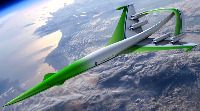
Lockheed Martin and Boeing have both submitted designs to NASA depicting their ideas about the supersonic transport of the future. Boeing’s team recommended a fixed-wing configuration with a V-tail and engines above the wing. The airplane could carry 120 passengers and cruise at Mach 1.8 with a range of about 5,000 nautical miles. Boeing’s study also found sonic boom noise could be reduced to 65 to 75 decibels, which would make it possible for a supersonic transport to operate at maximum cruise speed even over land. Lockheed’s simulation uses an “inverted-V” surface above the wing that would minimize the shockwave by disrupting the airflow behind the aircraft. The designs are meant to show concepts that could be viable within 20 to 25 years.
NASA funded the $1.8 million effort back in 2008 to generate new ideas for revolutionary technologies that could minimize sonic booms and fuel emissions. The teams researched not only what the vehicle of the future might look like, but also laid out a roadmap to an industry-wide path that would make the vision a reality. Boeing said its study concludes that a supersonic aircraft could be economically and environmentally viable in multiple markets. NASA’s project doesn’t provide funding for further development of the concepts, but Boeing said it expects to announce updates soon about the future of its research program.


































